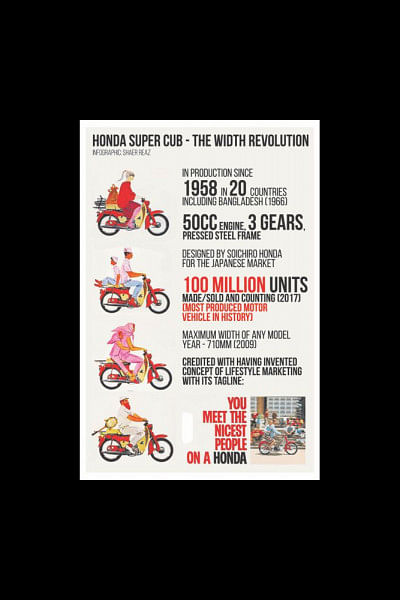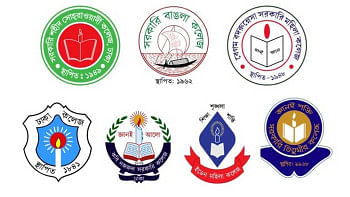The revolutionary concept of width

About two years ago, James May, mop-haired British TV personality and certified automotive encyclopedia-on-legs, was still presenting for Top Gear, the BBC's acclaimed show on cars. During more than a decade of employment at the BBC, he's presented several spin-off series', the most memorable of which is probably an in-depth look at various attempts to produce a "car of the people", in essence taking a look at the various approaches to making the automobile an accessible and readily usable tool for the masses. Through his witty and often quite eloquent posturing on the challenges of engineering a car for the masses, May stumbles upon a few concrete truths about mass mobility that is widely applicable—even in Bangladesh.
During an episode highlighting Japan's attempts at ensuring mass mobility, James May putts around tiny alleyways in Tokyo on a Honda Super Cub, a 50cc motorbike that offers a solution to the biggest problem facing traffic systems worldwide—width. With undeniable logic, he states the problem as it is—roads can be nearly infinitely long and urban environments can fit quite a good amount of cars if they're small in length, but that doesn't aid mobility as much as reducing the width of the vehicles plying the streets in mega-cities. He goes on to prove the point by winning a cross-city race between his puny motorbike and a kei car (an urban automobile concept nearly unique to Japan, with restrictions placed on engine size as well as overall dimensions so as to be eligible for exemption from tolls and congestion tax).
Motorbikes like the Honda Cub sold in the millions, especially in tightly packed Asian cities such as Hong Kong, Manila and Tokyo as well as in developing nations like Vietnam, Cambodia, Thailand and Indonesia. Despite growing incomes and increasing standards of living, people in these places held on to the idea of two-wheeled transport because it was the most efficient mode of transport in sprawling, densely populated urban areas. Even if individuals could afford it, owning a car was just more of a hassle when owning a motorbike meant reaching your destination faster and using less fuel per kilometre to do it.
In Bangladesh, as is the case with neighbouring giant India, motorbikes are essential transport for lower-middle class families. While the motorbike has been serving the upwardly mobile social classes faithfully for decades, the common case of social climbers earning beyond a certain point has led to an explosion in the number of cars on the roads. While there hasn't been any research done locally on the topic to date, most people no doubt consider owning an automobile to be a sign of prestige in a growing economy, despite the common complaint of unbearable traffic and constant tailbacks in Dhaka.
Between January and June 2016, 11,650 private passenger cars were registered with the Bangladesh Road Transport Authority (BRTA), while 21,062 were registered in the year 2015. Till June 2016, the grand total of all types of motorised vehicles on the road, including commercial and public transport, stand at 26,40,349 according to BRTA records. Of these, 15,25,283 are motorbikes.
The Bangladesh government has taken many steps to restrict further expansion in the number of vehicles plying the roads. Restrictive supplementary duty on vehicle import, high price of fuel and significant cost of vehicle registration have tried to discourage the purchase of vehicles, but the tide seemingly cannot be stopped. Even an expanding budget allocation to the transport sector has failed to register an impact in ensuring easy mobility and in easing traffic congestion.
What works, then? If only the people buying cars bought motorbikes instead. Or at least resorted to using motorbikes to travel in regularly gridlocked areas instead of sitting for hours in traffic and posting long rants on social media.
Ride sharing startups like Pathao have recently succeeded in making the motorbike a viable mode of transport for much of Dhaka city, by providing cheap and fast transport to students, working professionals and a source of income for motorbike users wanting to earn a little extra on the side. While some genuine concerns regarding passenger safety have been raised, it still stands to reason that someone heading to work during rush hour on a shared motorbike ride reduces the number of cars plying the roads. The competition from a local startup such as Pathao proved so formidable that even a global firm like Uber had to launch UberMoto, an additional Uber service that provides shared motorbike rides to users. If that isn't a step forward in the right direction, it is difficult to see what else is. With proper support from the government and an effective regulatory body that ensures user safety and etiquette compliance on the part of the service providers, motorbike ride sharing might be the answer to easing congestion inside Dhaka effectively.
It will take a concerted effort to let go of the air-conditioned, chauffeur-driven chariots of pride championed by people across socio-economic classes. Once people stop viewing the automobile as a sign of prestige and power and start seeing it as a source of daily misery and increasing costs, the nation can make the sensible switch to motorised transport that is a little less wide so everyone can have a little more space.
Shaer Reaz is in-charge, Shift, the automotive publication of The Daily Star.

 For all latest news, follow The Daily Star's Google News channel.
For all latest news, follow The Daily Star's Google News channel. 



Comments